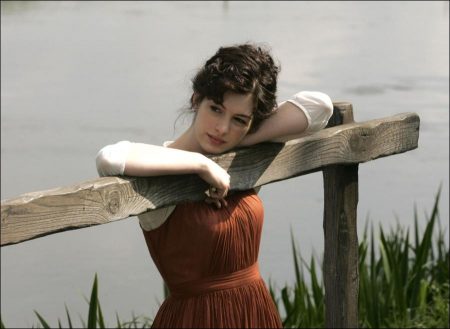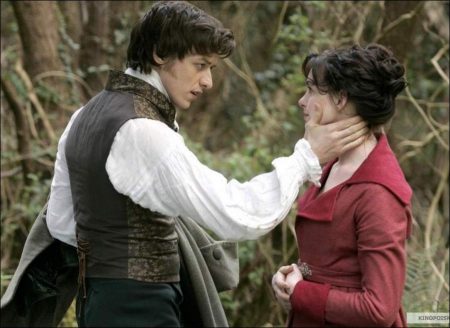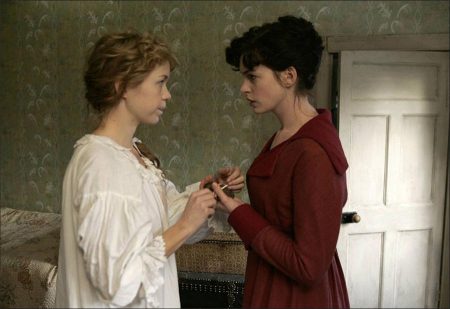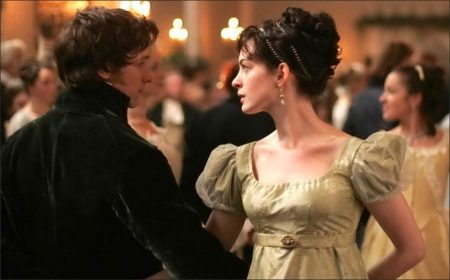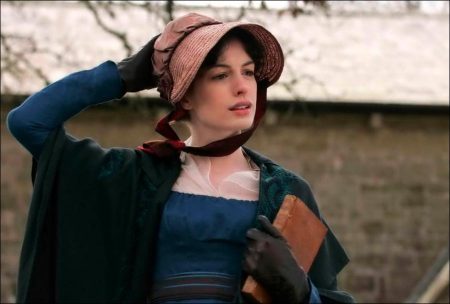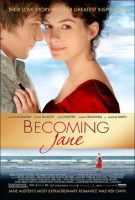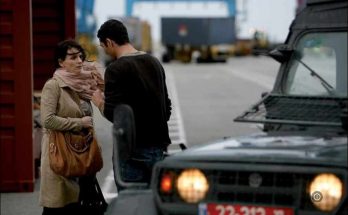Tagline: Their love story was her greatest inspiration.
Becoming Jane is an imaginative romantic comedy in the spirit of Jane Austen that places young Jane herself at the center of a witty, enchanting romance not unlike those that would later captivate millions in her celebrated works of literature.
The film spins the few known facts surrounding Austen’s real-life flirtation with the Irish lawyer, Tom Lefroy, into a tale about the kind of personal passion and social complications that could have inspired Jane to become the ingenious and utterly timeless observer of human relationships and romance that she soon did. Indeed, the story playfully references the characters and themes that wend their way through her six novels.
The year is 1795 and young Jane Austen (Anne Hathaway) is a feisty 20 year-old and emerging writer who already sees a world beyond class and commerce, beyond pride and prejudice, and dreams of doing what was then nearly unthinkable – marrying for love marrying for love, without any regard for financial well-being at all; in other words, their romance was based not on sense, but on sensibility or feeling, as the word meant in her day and in her book title, Sense and Sensibility.
Naturally, her parents (Julie Walters and James Cromwell) are searching for a wealthy, wellappointed husband to assure their daughter’s future social standing. They are eyeing Mr. Wisley (Laurence Fox), nephew to the very formidable, not to mention very rich, local aristocrat Lady Gresham (Maggie Smith), as a prospective match. But when Jane meets the roguish and decidely non-aristocratic Tom Lefroy (James McAvoy), sparks soon fly along with the sharp repartee. His intellect and arrogance raise her ire – then knock her head over heels.
Now, the couple, whose flirtation flies in the face of the common sense of the age, are faced with a terrible dilemma. If they attempt to marry, they will risk everything that matters – family, friends and fortune. But navigating the stormy waters between romance and duty, heart and head, sensibility and sense, goodness and greatness is all a part of BECOMING JANE.
Becoming Jane is a 2007 British-Irish biographical romantic drama film directed by Julian Jarrold. It depicts the early life of the English author Jane Austen and her lasting love for Thomas Langlois Lefroy. American actress Anne Hathaway stars as the title character, while her romantic interest is played by Scottish actor James McAvoy. Also appearing in the film are Julie Walters, James Cromwell and Maggie Smith. The film was produced in cooperation with several companies, including Ecosse Films and Blueprint Pictures. It also received funding from the Irish Film Board and the UK Film Council Premiere Fund.
The film is partly based on the 2003 book Becoming Jane Austen by Jon Hunter Spence, who was also hired as historical consultant. The final screenplay, developed by Sarah Williams and Kevin Hood, pieced together some known facts about Austen into a coherent story, in what co-producer Graham Broadbent called “our own Austenesque landscape.” According to Hood, he attempted to weave together “what we know about Austen’s world from her books and letters,” and believed Austen’s personal life was the inspiration for Pride and Prejudice.[3] Jarrold began production of the film in early 2006, opting to shoot primarily in Ireland as he found it had better-preserved locations than Hampshire, England, where Austen was raised.
The Origins of the Story
It has long been surmised that Jane Austen, who wrote so brilliantly of romantic relationships yet herself remained unmarried, never knew undying passion. Yet recently, this notion has been turned upside down by several Austen historians who have proposed the possibility of a fervid romance between 20 year-old Jane, fresh off beginning her adult writing career, and the equally young, ambitious and smart Irishman Tom Lefroy. Was it this seemingly brief, deep love affair – with its apparent rapid build-up and heartrending demise — that inspired the great romantic novels Austen was about to write?
The full truth of what really happened between Austen and Lefroy will never be known. The importance and extent of Austen’s true feelings for Lefroy will continue to be hotly debated. And yet, the thrilling notion of Jane Austen in the middle of her own heated, rebellious love story was nearly irresistible to fertile imaginations who saw it as an intriguing jumping off point for a fictional, fun romantic comedy in the Austen spirit.
Thus was born BECOMING JANE, a film that boldy imagines what might have happened if a youthful Jane Austen fell in love. The story not only places Jane at the center of her own courtship story, but merrily and artfully filters characters and elements from each of Austen’s six novels into the mix.
Bringing a modern sensibility to the story is director Julian Jarrold, who made a rousing feature film debut with the critically admired comedy Kinky Boots. The film pairs rising young stars Anne Hathaway, most recently seen starring in the hit comedy The Devil Wears Prada, and James McAvoy, who came to the fore in the Oscar-winning The Last King of Scotland, as Jane Austen and the man who, perhaps, might have stolen her heart and awakened her still deliciously relevant views on how status, money, family, freedom and true love really work.
There have, of course, been scores of movies drawn from or inspired by Austen’s famous books – Emma, Pride and Prejudice, Sense and Sensibility, Persuasion, Northanger Abbey and Mansfield Park – ranging from boldly contemporary comedies to painstaking period adaptations. Indeed, People Magazine recently declared that we are living “in a Jane Austen moment.” As Joan Ray – an Austen scholar, former President of the Jane Austen Society of North America and Professor of English at the University of Colorado, Colorado Springs – notes: “The amazing thing about Jane Austen is that she appeals to pop culture, to academic scholars, and to everyone in between. She’s so multi-layered and so in tune with human nature, she can be approached on so many different levels.
Yet, suprisingly, Austen herself has never been a cinematic character, until now. It all began when screenwriter Sarah Williams first learned about the possible serious romance between Austen and Lefroy – and couldn’t help but try to envision what might have really gone on between them, behind doors that will always be closed to us more than 200 years later.
Williams was aware that there was only a handful of known facts about Austen and Lefroy, which had produced multiple interpretations, ranging from biographer Jon Spence’s belief in their sharing a deep and abiding love to others who saw nothing but the couple’s enjoying a frivolous flirtation between them. But this open-ended reality would allow Williams, and later co-writer Kevin Hood, the freedom to turn the speculative story of Austen’ youthful flirtations into the kind of delightful and dramatically satifsying romantic fiction Austen herself continues to inspire.
Wiliams approached Douglas Rae and Robert Bernstein of Ecosse Films, which had previously won acclaim for the film Mrs. Brown, starring Judi Dench in another unlikely love story between historical figures – that of Queen Victoria, the most powerful woman in the world, and the lowly Scottish highlander in whom she confided. Though BECOMING JANE would delve deeper into fiction, the premise grabbed the producers. “It was intriguing to think that beneath Jane Austen’s strict interior was a beating heart which could have been awoken by this relationship,” says Bernstein.
Rae and Bernstein subsequently recruited accomplished writer Kevin Hood to bring fresh insight to the script. “Kevin has a wonderful romantic sensibility,” says Bernstein. “There is a poetic quality about his writing as well as a rigorous emotional truth which we all thought was important for BECOMING JANE.”
Hood was instantly compelled by the story and the argument of some historians that Tom Lefroy stirred Jane Austen’s heart far more than anyone ever realized. Although it would require time travel and telepathy to know in truth what had occurred between the two, Hood was more inspired by the idea that this rumored brush with doomed passion could become a window into the themes of which Austen is still considered the ultimate master. “The period of a woman’s life before marriage was what she always wrote about. It was a subject of perpetual interest to her. She also returned again and again to the figure of the attractive, unreliable young man,” Hood notes. “So arguably, this could be based on her personal experience. That was our starting point.”
From there, Hood began weaving fact and fiction together, merging elements of Austen’s real life with witty allusions to events and characters from her novels, turning the screenplay into a fun, fresh take on the universe Austen created. “The majority of characters seen in the film did exist, as did many of the situations and circumstances,” he explains. “Throughout, we weave together what is now known about Austen’s world from her books and letters, creating a rich Janeite landscape.”
When producer Graham Broadbent of Blueprint Pictures read the completed script, he was immediately impressed by its boldly different perspective. “This is Jane Austen not as a dusty old spinster [as promoted by the Victorians] but as a 20 year-old in a love affair which couldn’t proceed further for societal reasons and other pressures of the time. What the writers had done was to take the encounter between Jane and Tom Lefroy, mesh it with Jane’s real family and other known experiences and set it all against a wonderfully imaginative world inspired by Austen’s fiction.
The result was something that, like Austen herself, seemed both new and timeless. Sums up Bernstein: “At bottom, BECOMING JANE is simply a love story about two young people who know they can’t be together. There’s humor in their interaction, which in the beginning has a sort of screwball element, but the characterizations are also very sophisticated. Ultimately, it’s very accessible because Jane and Tom are dealing with issues people still deal with all the time.”
Now, the producers set out in search of a director who could bring his own distinctive, modern touch to the story. They quickly found themselves drawn to Julian Jarrold, who had brought both heart and humor to his debut feature, Kinky Boots, an uplifting comedy about a female impersonator who turns the fate of luckless shoe factory around. “I liked Julian’s style because it was modern and visceral, and I just had a feeling that he was the right choice,” says Bernstein. “This piece needed to be handled with delicacy but also with a certain amount of brio, and Julian had both.”
Jarrold, already a fan of Austen, was knocked out by the screenplay and inspired by its potential. “It is a love story but much more besides, with so many layers and interesting ideas,” says the director. “Apart from the romance, I was very attracted by the themes of imagination and experience. I thought the writing was fresh and surprising and offered a fascinating insight into Austen’s life, focusing on her as a young woman full of exuberance. I was also very attracted to the more provocative scenes that don’t normally appear in an Austen film. We see the more risqué side of Regency life, a side that Jane Austen was certainly aware of, but only occurs off-stage in her novels.”
The excitement also came with an acknowledged risk, however. In approaching Jane Austen’s youth and heart in such an imaginative way, Jarrold knew he would be stepping into dangerous territory. He was well aware of how lovingly devoted some Austen’s fans are and how staunchly loyal some can be to upholding her Victorian legacy. But even so, Jarrold couldn’t resist the idea of allowing the vaunted icon to become a real woman with complex emotions and a vulnerable heart for the first time on screen.
“Everyone has their own treasured image of Jane Austen,” says Jarrold. “Yet, despite the huge numbers of biographies, we know so little about her real life. Her letters are an important source of information, but unfortunately, many have not survived. Her first letter about her ‘flirtation’ with Tom Lefroy probably survived only by mistake. With this film I wanted to see Jane portrayed as a real person of flesh and blood and not as a museum piece.“
Jarrold couldn’t wait to reveal Austen not as the prim and proper spinstress of of the old, Victorian stereotype, to which some fans still cling, but as a young woman and artist very much in love with life and its infinite possibilities. “I hope BECOMING JANE works as a fresh and interesting take on the world of Jane Austen,” he summarizes. “I hope the poignancy between the happiness she allows her heroines and the reality of her life resonates with people. I hope it brings even more people to her books and reveals another side to the author we still love so much.”
Continue Reading and View the Theatrical Trailer
Becoming Jane (2007)
Directed by: Julian Jarrold
Starring: Anne Hathaway, James McAvoy, Maggie Smith, Julie Walters, James Cromwell, Helen McCrory, Joe Anderson, Lucy Cohu, Laurence Fox, Jessica Ashworth, Lucy Cohu, Eleanor Methven
Screenplay by: Kevin Hood, Sarah Williams
Production Design by: Eve Stewart
Cinematography by: Eigil Bryld
Film Editing by: Emma E. Hickox
Costume Design by: Eimer Ni Mhaoldomhnaigh
Set Decoration by: Johnny Byrne, Jenny Oman
Art Direction by: David McHenry
Music by: Adrian Johnston
MPAA Rating: PG-13 for brief nudity and mild language.
Distributed by: Miramax Films
Release Date: August 3, 2007
Views: 90
